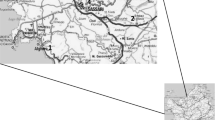Abstract
We have determined bone strontium (Sr), barium (Ba), calcium (Ca), and zinc (Zn) content in 24 samples belonging to adult individuals who died toward the end of the 18th century and were interred in a church’s floor on the island of Tenerife, comparing the results with those obtained in 14 prehistoric samples of the same island and also with those of 7 modern controls. No differences were observed between the two ancient groups, which showed higher bone strontium and barium than the modern sample, and a slightly lower Ba/Sr ratio, thus pointing to consumption of marine sources.
Similar content being viewed by others
References
M. Báez, T. Bravo, and J. F. Navarro-Mederos,Canarias. Origen y poblamiento. Círculo de Estudio Sociales de Canarias. Madrid, 1983.
A. Rumeu de Armas,La conquista de Tenerife, Aula de Cultura de Tenerife, Santa Cruz de Tenerife, 1975.
A. Ciouranescu,Historia de Santa Cruz de Tenerife. Goya, Santa Cruz de Tenerife, 1978.
Benítez L. Cola, Santa Cruz, Bandera amarilla (epidemias y calamidades, 1494–1910. inAyto de Santa Cruz de Tenerife, Tingraf, Santa Cruz de Tenerife, 1996.
CA Baud. Fluor et strontium dans les os anciens. Homme et milieu. Aproches páleoanthropologiques,CNRS, 33–39 1989.
A. Sillen and M. Kavanagh. Strontium and paleodietary research,Yearbook of Physical Anthropology,25, 67–90 1982.
J. B. Lambert and J. M. Weydert-Homeyer. The fundamental relationship between ancient diet and the inorganic constituents of bone as derived from feeding experiments,Archaeometry,35, 279–294, 1993.
T. D. Price, M. J. Schöninger, and G. J. Armelagos. Bone chemistry and past behavior: an overview.J. Hum. Evol.,14, 488–491, 1985.
R. Gilbert, Stress, paleonutrition, and trace elements, inThe Analysis of Prehistoric Diets, R. I. Gilbert and J. H. Mielke, eds., Academic Press, Orlando, pp. 339–358, 1985.
M. J. Schöninger, Diet and status at Chalcatzingo.J. Anthrop. Sci. 51, 295–310 (1979).
M. J. Schöninger, Reconstructing prehistoric human diet.Homo 39, 78–99 (1989).
J. H. Burton and T. D. Price. The ratio of barium to strontium as a paleodietary indicator of consumption of marine resources.J. Archaeol. Sci. 17, 547–557 (1990).
J. Ezzo. Zinc as a paleodietary indicator: an issue of theoretical avalidity in bonechemistry analysis.Am. Antiq. 59, 606–621 (1994).
M. Y. Iscan and P Miller-Shaivitz. Discriminant function sexing of the tibia.J. Forensic Sci. 29, 1087–1093 (1984).
D. Ferembach, I. Schwidetzky, and M. Stloukal, Recommendations pour determiner l’age et le sexe sur le squelette.Bull. Mem. Soc. Anthrop. Paris 6 (série XIII), 7–45 (1979).
Atomic absorption spectrophotometry. Public no. 85-100009-00. Varian Australia Pty Ltd. Mulgrave, Victoria, Australia, 1989.
C. Gilbert, J. Sealy and A. Sillen, An investigation of barium, calcium and strontium as paleodietary indicators in the Southwestern Cape, South Africa,J. Archaeol. Sci. 15, 123–129. (1994).
L. Klepinger, Nutritional assessment from bone.Am. Rev. Anthropol. 13, 75–96 (1984).
R. G. V. Hancok, The abuse of bone analysis for archaeological dietary studies.Archaeometry 31, 169–179 (1989).
E. González-Reimers and M. Arnay-de-la-Rosa, Ancient skeletal remains of the Canary Islands: Bone histology and chemical analysis.Ant. Anzeiger. 50, 201–215 (1992).
J. Velasco-Vázquez, M. Arnay-de-la-Rosa, E. González-Reimers, and O. Hernández-Torres, Paleodietary analysis of the prehistoric population of El Hierro (Canary Islands).Biol. Trace Elem. Res., in press.
Author information
Authors and Affiliations
Rights and permissions
About this article
Cite this article
Arnay-de-la-Rosa, M., Gonzalez-Reimers, E., Velasco-Vazquez, J. et al. Bone trace element pattern in an 18th century population sample of tenerife (Canary islands). Biol Trace Elem Res 65, 45–51 (1998). https://doi.org/10.1007/BF02784113
Received:
Revised:
Accepted:
Issue Date:
DOI: https://doi.org/10.1007/BF02784113




